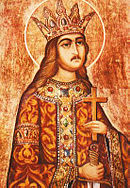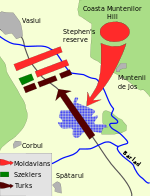Battle of Vaslui
The Battle of Vaslui , also called Battle of Podul Înalt (High Bridge), was held on January 10, 1475 between Prince Ștefan III. cel Mare of Moldavia and the Ottoman Beylerbey of Rumelia , Hadân Suleiman Pasha . It took place on Podul Înalt (High Bridge), near the city of Vaslui in the Principality of Moldova .
history
background
The high gate had asked Prince Stefan to pay tribute. Since the Moldovan ruler ignored this request, Constantinople felt compelled to act.
Radu cel Frumos (Radu the Fair) had pushed the elected Wallachian prince Basarab Laiotă from the throne with the help of the gate in 1473, who fled to the Vltava. In December of that year there was an Ottoman raid in the south of Moldova from Wallachia . Radu, a Turkish vassal, plundered and pillaged with an army of 17,000 Turks and 12,000 Muntenians as far as Barlad . With the support of Stefan Laiotă succeeded in regaining his throne in March 1474, but months later he was forced to submit to the Turks, which led to an unsuccessful military action by Stefans. The aim of the Ottoman Sultan Mehmed II was to make Moldova a tributary vassal state after the subjugation of Wallachia. In anticipation of such a plan, Stefan, with the support of Transylvanian contingents, overthrew the Laiota and put Basarab the younger on the throne, but the latter could not hold out.
The conflict between Stefan and Mehmed II intensified as both of them registered their claims to the southern region of Bessarabia (today: Budschak ). The region had belonged to Wallachia , but came under Moldovan influence during the reign of Prince Petru I and was annexed by Roman I of Moldova in the late 14th century . Under Alexandru cel Bun, the area was an integral part of the Principality of Moldova and was successfully defended in 1420 against the first Ottoman attempt to take the Chilia fortress. The ports of Chilia and Cetatea Albă were of great importance for Moldovan trade, as the old trade route led from Caffa via Cetatea Albă and Chilia and then went through Suceava to Lviv in Poland (now in Ukraine).
In anticipation of a Turkish invasion, Stefan turned to the Polish ruler Casimir II and the Hungarian King Matthias Corvinus , who had recognized the independence of the Principality of Moldova after the Battle of Baia , with requests for help . The ruler also sent a letter to Pope Sixtus IV from his camp in Vaslui, requesting other princes to prepare “against the Ottomans and their terrible power”, saying that “Moldova is completely ready with all its soul and with everything the strength that God had given her to fight for Christianity with all her might ”. Although the Pope found words of praise, he did not act, after all Stefan was not a Catholic, but an Orthodox Christian. Matthias and Kasimir sent him only a few soldiers to support him and did not support him financially at all. Matthias sent 5,000 Székler and Hungarians, Casimir only 2,000 Poles.
Preparations
Stefan knew about the stifling Ottoman troop strength of almost 120,000 men on foot (Turks, Tatars and 17,000 Muntenians ) and 30,000 cavalrymen under the leadership of Hadân Suleiman Pasha , compared to his roughly 40,000 poorly armed Moldovan fighters, many of them farmers who were recruited directly from the field work as well as around 7,000 Székelern and Hungarians and 2,000 Poles under the leadership of Michael Buczacki. He therefore decided to confront the Turkish army at a place and time of his choosing and chose the place where the rivers Racova and Vaslui (also: Vasluie m) flow into the Bârlad , a swampy, often fog-streaked terrain on which such a large army as the Ottoman could not properly develop.
The Ottoman troops , withdrawn from Albania, camped in Wallachia for two weeks before they set out on the march. Stefan had all residents with their belongings and animals evacuated in the vicinity of the expected path and even had the houses set on fire. The stored grain was hidden in prepared pits. He also ordered the wells and stagnant water to be poisoned. The enemies did not find a comfortable shelter for the nights, and they suffered from a lack of food and water. As a result, the opposing army reached the battlefield already tired and weakened.
course
On the day of the battle there was thick fog so that the Turkish scouts could not spy on the preparations of the Moldovan army; it had also become extremely muddy due to a hot dip.
According to the Turkish chronicler Kemal Pascha zâde , the prince stopped the advance of the Turkish army by shelling them from cannons, bombards and arrows. From the valley surrounded by dense forests, the Turks did not manage to encircle the Moldovan armed forces because of the trees and the muddy soil. This resulted in a war of attrition, in which the Moldovans held the better positions. Stefan, who first led the operation personally from a somewhat secure place, had the Turks surrounded and then attacked them from behind and from the flanks.
Nevertheless, danger should arise again. The Albanian army leader Mihaloglu Ali-Bei formed a heap made up of elite Janichars and stormed towards the Moldovans. After the first ranks of the Moldovans had been slaughtered, Stefan threw himself into the fray to encourage his people and succeeded in forcing the enemy to retreat. Then he let the farmers hidden in the forest on the hill next to him make a great noise with all sorts of equipment, which led the enemy to believe that they were being attacked from the left flank. After they had regrouped and organized to defend themselves, Stefan and the bulk of his army, coming from the river Bârlad, fell in the back of the Turks and blocked any possibility of escape and the Ottomans began to flee haphazardly. Many drowned on their flight in the Sereth , the others were persecuted as far as the Danube in the Dobruja and killed.
According to Venetian and Polish records, the number of losses on the Ottoman side amounted to well over 40,000 soldiers. Four pashas were killed and more than a hundred fighting standards conquered.
epilogue
The Ottoman defeat has been described as "the greatest ever recorded by the cross against Islam". After the Battle of Vaslui, Mara Branković noticed that the battle had been one of the greatest defeats for the then seemingly invincible Ottoman Empire.
According to the Polish chronicler Jan Długosz , Stefan did not celebrate his victory, but fasted forty days with bread and water and forbade anyone to ascribe the victory to him, rather he insisted that it was given by God.
After the victory, Stefan made gifts to the Polish and Hungarian rulers and the Pope in the form of parts of the rich booty and prisoners, but at the same time asked for military and financial help. This request was refused. After all, the prince was honored with the title “ Athleta Christi ” by Pope Sixtus IV , who called him “Verus christiane fidei athleta” (the true defender of the Christian faith).
Between May and September 1488, Stefan had the Voroneț monastery built to commemorate the victory at Vaslui.
literature
- Ion Cupșa: "Bătălia de la Vaslui (10 January 1475)", Editura militară, București 1975
- Gheorghe Duzinchevici: "Ștefan cel mare și epoca sa", Editura politică, București 1973
- Constantin C. Giurescu: "Istoria României în date", Editura Enciclopedică Română, București 1971, p. 104
Individual evidence
- ^ Constantin C. Giurescu : "Istoria României în date", Editura Enciclopedică Română, București 1971, p. 104
- ^ Clifford Rogers: "The Oxford Encyclopedia of Medieval Warfare and Military Technology", Volume 1, Verlag Oxford Univ. Press, New York 2010, p. 401
- ↑ Constantin C. Giurescu, Istoria românilor: Dela Mircea cel Bătrân si Alexandru cel Bun până la Mihal Viteazul , București 1943, p. 63.
- ↑ România, Arhivele Statului; "Revista arhivelor", Volume 47, p. 144
- ↑ Istoria RPR, Editura școlară, Bucharest 1954, p. 146 f.
- ↑ Nicolae Iorga: "Istoria lui Ştefan cel Mare" 1904, new edition by Editura Artemis, București 2004, p. 127 ff.
- ↑ Archived copy ( memento of the original dated November 18, 2005 in the Internet Archive ) Info: The archive link was inserted automatically and has not yet been checked. Please check the original and archive link according to the instructions and then remove this notice.
- ↑ http://www.timpul.md/articol/top-zece-cele-mai-mari-batalii-ale-romanilor-46508.html






